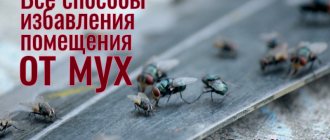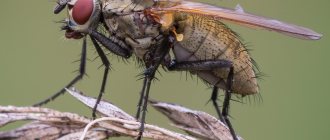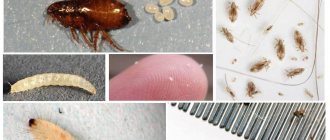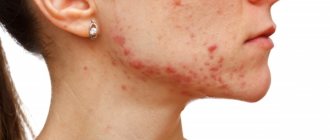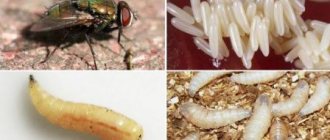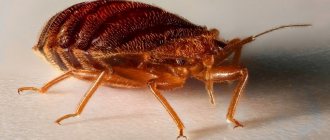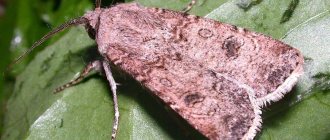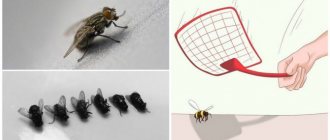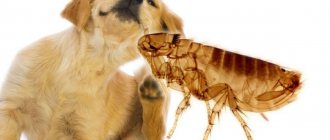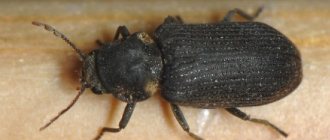The appearance of any type of insects in the apartment causes a lot of trouble for the owners. In addition to their unpleasant appearance, which you can judge from the photo, they can cause significant damage to products, items made of fur, wool, leather, as well as furniture and even books. One common kitchen bug is the bread grinder. This pest feeds on food supplies, especially loves flour and flour products, cereals, dried fruits, tea, tobacco, medicinal herbs and even animal food.
You can distinguish the bread borer from another type of beetle by its oblong brown body, 2-3 mm in size, covered with hairs. Its larvae have a curved shape and reach 5 mm in length. Both adults and their larvae can cause damage to products. They make holes in their food, eating everything that gets in their way. Therefore, if you find small holes in bread that resemble passages, there is no doubt that the presence of a grinder beetle is present.
Precautionary measures
Simple precautions will help you avoid such an unpleasant problem as kitchen pests
- To prevent bugs from infesting flour and cereals, they must be stored at medium humidity in a well-ventilated area;
- You need to make sure that there are no raw or undried foods (dried fruits, vegetables, wet cereals) in the kitchen cabinets. If there are any, then the mucoed will definitely settle in them;
- It is mandatory to regularly inspect products and shelves. Make sure that cereals do not sit for a long time; long-term storage is the main cause of insects.
- Keep cloves, bay leaves and matches in your kitchen cupboard to repel pests.
- Store cereals and grains in plastic or glass containers with an airtight lid.
- If you notice the first signs of spoilage of food, immediately throw it away or rinse or sift through a sieve.
- Carry out general cleaning at least once a month using disinfectants.
Source: www.tofp.ru
How to get rid of pests in the kitchen
Bread grinder
It is much easier to remove beetles than the annoying ubiquitous cockroaches or ants. Before you get rid of the bread grinder in the kitchen, you should understand that this insect does not hide in secluded places and does not go out hunting at nightfall. The borer lives and reproduces directly in the substrate, mainly in food. It is enough to find the source of infection and dispose of it.
The action plan for getting rid of pests comes down to an audit of all kitchen utensils. It is necessary to carefully check the contents of all jars and boxes. Decorative decorations made from natural materials on the cabinets cannot be ignored.
The success of the fight against grinders is determined by the thoroughness of the search for spoiled products. If you were able to find a cluster of beetles in one place, this does not mean that they are no longer found anywhere and that you managed to completely get rid of them. All provisions need inspection. Detected contaminated products must be disposed of, and the beetles are destroyed by mechanical action, that is, by pressing down. After completing search and liquidation work in the kitchen, the internal surfaces of the cabinets should be washed and treated with a solution of vinegar and soda. Soak jars in which contaminated products were found in soapy water and wash. It is irrational to get rid of bread borers using insecticides.
If it is suspected that products are contaminated, but there are no obvious signs, the following measures are taken:
- the cereals are sifted and heated in the oven;
- contaminated products must be placed in the freezer for 12 hours, then fried in a frying pan for 15-20 minutes;
- Pour cold water over the beans and peas; if infected, the larvae will float to the surface.
Maliciousness
In the grain borer, both the beetle and the larva feed intensively.
During development, the larva of one generation destroys about 30% of the dry matter of the wheat grain. A beetle can destroy an amount of grain equal to its body weight.
As a result of the feeding of larvae or beetles, only a thin, gnawed shell remains from the grain. Larvae and beetles excrete very large amounts of excrement.
When the larva develops inside the grain, it pushes its excrement with particles of starchy endosperm onto the surface of the grain through the entrance hole.
Thus, with severe infection, a large amount of excrement, the so-called mucheli, accumulates in the grain mass, which has a honey-mouldy smell, characteristic of infection with the grain borer.
Damages whole dry grains of all cereal grains, rice, sorghum, buckwheat, corn, barley, peanuts, various cereals, as well as crackers.
Why do bugs appear?
First, let's figure out where beetles come from, because they can often be found in kitchens where perfect order reigns. Insects enter the house through open windows and cracks in them. They can also be brought into the house along with contaminated products (for example, low-quality cereals).
For their habitat, beetles choose places with a large amount of easily accessible food; they often settle in dry trees. Poorly closed bags of cereals and flour attract them like a magnet. Pests will not refuse pasta, nuts, and dried fruits. They attack spices, sweeteners, and can settle in teas and coffee.
Although beetles do not carry diseases, they make life very difficult for the owners of the house in which they live
It is important to detect the presence of insects in time, otherwise they will scatter to other rooms. This is especially true if you eat outside of the kitchen and have a habit of accumulating dirty dishes (cups by the bed also count)
Delay in this case is fatal: bugs can be found among fabrics, papers, and furniture.
Causes and signs of pest appearance
Signs of the appearance of grinder beetles:
- small holes on the surface of wooden structures, furniture;
- the appearance of wood pollen, similar in color to mustard powder;
- rustling, tapping inside solid wood in the evening, at night;
- characteristic odor from insect secretions, insect pheromones;
- if you remove the outer layer, you can see the grooves and passages of the larvae.
You need to start exterminating beetles immediately, as soon as the first signs appear.
It is not so difficult to discover that a furniture grinder has settled in the house and has managed to hatch larvae in the very depths of the furniture. There are a number of signs by which it is easy to determine the location of the pest. These include:
- monotonous tapping inside the furniture in short series with repetitions, clearly audible and with a unique rhythm;
- holes on furniture with a small diameter;
- traces of insect activity on furniture.
We suggest you read: How to remove midges from the kitchen A heavily damaged surface with bugs flying out of it from time to time will indicate a high degree of damage. The absence of holes in the surface of a tree cannot guarantee the absence of pests. The level of infection can be determined at the first sounds emanating from the furniture.
Methods of disposal
Unlike a cockroach, which can wander from one place to another, the bread grinder, having found a suitable shelter, settles there, attracting females for mating. Therefore, first of all, it is necessary to find the habitat of the pests, then half the battle will already be done.
If single individuals are detected, all food supplies will have to be shaken up, from groceries to cereals and dried fruits. It is not difficult to detect the outbreak, since the beetles make passages in the food, and small dust often remains on the surface. Both grinders and their larvae are usually found inside such a product.
The search issue should be approached with maximum responsibility and thoroughness. If you miss even a few individuals, they may soon multiply again and spoil other food supplies. Products affected by beetles must be thrown away, preferably directly into the street or down the drain. Single pests should be crushed.
In case of minor damage to products, the following measures can be taken:
- Sift the cereal through a fine sieve, and then bake in the oven at a temperature of 70 degrees and above. Flour cannot be heated; it is better to throw it away immediately.
- Bean grains must be filled with water with salt dissolved in it, and wait until the beetles float to the surface. Then, dry the grains on a cotton cloth.
- Some products can be left in the freezer for a day, and then fried for 10-15 minutes.
You can get rid of the bread grinder using folk remedies. They are not only effective, but also safe, since their compositions will not harm the health of people and pets, which cannot be said about chemicals.
- Pyrethrum powder. It is sold in pharmacies and mixed with water. You should wipe the cabinets with this solution once a week until the insects are completely gone.
- Borax. Used to control many pests, including borer beetles. You need to make special balls from it, mixing it with powdered sugar and chopped millet. These balls should be placed in the corners of the kitchen furniture.
- Borax and yeast. Another effective way to combat beetles is to use borax mixed with yeast and sugar. The ground components must be scattered on paper and placed in the places where insects were found.
Chemicals are usually not used to control this pest for many reasons. Firstly, since the habitat is mainly food, after treatment with toxic compounds, they will no longer be suitable for food. Secondly, if you spray a cabinet with food in tightly closed packages, the effect of the product will not be visible, since it does not penetrate inside the bags and boxes. Thirdly, the use of chemical compounds is unsafe for the person who sprays them.
The only place where the use of chemicals will be effective is on bookshelves. If beetles have attacked a collection of books, then the cabinet or rack can be treated by thoroughly spraying or wiping each shelf. Heavily affected books will have to be disposed of, as the product cannot penetrate deeply. You can save a book by heating it for a day and a half at a temperature of +55 degrees or leaving it in the cold of -15 degrees for 24 hours.
Prevention
Once the necessary measures have been taken to eliminate the borer beetle, care should be taken to ensure that it does not appear again. For this it is important:
- Store cereals and other bulk products in tightly closed containers. And also get rid of cardboard boxes and paper bags.
- Try not to accumulate large stocks of food at home, but purchase them only as needed.
- Before purchasing, carefully inspect groceries, flour, and cereals for holes, dust, beetles, and larvae.
- Before pouring the purchased product into a container, you need to rinse and dry it in the oven.
- You can keep food in the freezer for a day, for example, bread.
- Periodically inspect kitchen cabinets.
- It is best to store baked goods, dried fruits and nuts in the refrigerator.
- Wipe the surface of the countertop and sink dry if not in use.
- Cover the ventilation holes with fine mesh.
- It is better to wash dishes immediately after eating, and put uneaten food in the refrigerator.
- Maintain cleanliness in the kitchen and apartment.
It is better to take preventative measures and prevent the appearance of grinder beetles than to later get rid of annoying pests that can cause a lot of damage to food and other things.
Unfortunately, the bread grinder is not a rare occurrence both in the apartment and in the house. Its occurrence always causes a lot of concern among owners, since it indicates spoiled food, books, newspapers or other things. The success of pest control depends on the thoroughness of the search for its habitat, as well as subsequent treatment and the necessary prevention.
Traditional methods
To prevent the spread of the bread grinder in the kitchen, it is necessary to maintain perfect cleanliness and inspect purchased cereals and flour for the presence of the bug. For storage, use glass sealed containers. Products in paper, plastic or fabric bags are more susceptible to infection by the bread grinder, since it will not be difficult for an insect to gnaw through such material. As a protective measure, it is recommended to treat the cloth bag with a concentrated saline solution.
You can repel the pest with ordinary garlic, a few unpeeled cloves of which are recommended to be placed in flour. In containers with cereals, it is advisable to place gauze bags filled with salt or bay leaves, the smell of which insects simply cannot stand. You should periodically wipe the cabinet shelves with water and vinegar. It is advisable to store dried fruits, bread and nuts in the refrigerator. You should not buy cereals for future use, creating significant reserves - an excellent environment for the life of bread borer larvae.
Pest control methods at home
Getting rid of insects that have settled in your home is not easy, so get ready for a stubborn struggle.
The main methods of eliminating “uninvited guests” can be divided into the following groups:
- mechanical impact;
- chemicals;
- folk remedies.
Mechanical impact
Before carrying out procedures of this nature, you first need to get rid of contaminated products so that they do not harm your health. Containers and storage areas should be thoroughly washed with soap (dishes) or vinegar solution (cabinets, shelves).
It will not be superfluous to seal all the cracks in the baseboards, window sills and furniture. The remaining products, untouched by pests, should be packaged and taken outside the kitchen for 1–2 weeks. If the bugs do not appear, then you can use them.
When the number of bugs is minimal and they are quickly detected, you can try to save the remains of the cereal using heat treatment:
- heat the product in the oven at a temperature of 50 o C (for semolina and flour) or 100–120 o C (for other grains) for at least 10 minutes;
- expose cereals to low temperatures (-15 o C) for 24 hours;
- treat with ultraviolet light, placing it under the sun for several hours.
Before processing, it is necessary to sort out the grain products or sift them through a sieve, and then, before consumption, soak them in salt water and rinse.
Chemicals
It is advisable to use chemicals to kill insects in extremely advanced cases, when other means (including folk remedies) are not able to solve the problem.
The most harmless product that can be purchased at any pharmacy is pyrethrum powder.
They are sprinkled on food storage areas. The product is absolutely non-toxic for animals and people (even if accidentally ingested), but it is poisonous for crawling insects.
You can wash the cabinets with Domestos solution or another chlorine-containing product. It is advisable to repeat this procedure several times, since the effectiveness of a single use of this “weapon” to combat beetles is low.
“Anti-bug” is an impregnation that is used to protect wooden surfaces from the actions of grinders. Hazardous to humans if in contact with eyes or skin.
Remedies are intended for treating wood, but at the same time they are poison for mucoeds. But neither humans nor pets should breathe them.
Rogneda brand products will get rid of not only bugs, but also cockroaches and ants. When using, personal protective equipment must be used.
It should be noted that chemical control methods are not always the most effective. It is impossible to treat surfaces in contact with food and feed with drugs; moreover, they have a lot of side effects.
Folk remedies
To get rid of pests, sometimes it is enough to have the following ingredients available:
- vinegar;
- Bay leaf;
- nutmeg;
- garlic;
- lavender;
- sagebrush;
- borax.
You can prepare special bait traps for bugs. On shelves or in cabinets, you need to sprinkle nutmeg on an adhesive plaster, put peeled garlic cloves, bay leaves, or add these spices to containers for flour and cereals, after wrapping them in gauze. Another trap is made using sugar, borax and dry yeast, which are mixed in equal proportions. The resulting composition should be laid out on pieces of paper in cabinets, which will lure the bugs out of their hiding places.
There is an opinion that small pests cannot tolerate the smell of metal. By putting a nail, wire or just a piece of foil in a jar of cereal, you will get rid of annoying “visitors”.
You can use vinegar solution to wash food storage areas. Dried twigs or essential oils of lavender or wormwood are wonderful remedies against food moths.
Takes ~3 minutes to read
Cereal dishes are among the most popular in the daily diet. Many housewives prefer to purchase cereals in large quantities in order to always be ready to prepare this or that dish. But such thriftiness can backfire if insects take up residence in the reserves.
If bugs appear in the cereal, how to get rid of them will be a matter of first importance. How to deal with uninvited guests, and what to do to prevent their appearance?
What to do if bugs appear in flour and cereals
If you find bugs in the cereal, you need to take action immediately. They multiply very quickly, so don't hesitate.
The best option is to throw out all the cereals. The larvae are colorless and may not be noticed. But using it as food is not pleasant and is harmful to health. In cereals, insect waste products remain, which can cause digestive upset or poisoning.
Bugs can also be in unopened packages; they easily chew through the packages and settle in products. It is impossible to notice the holes. Therefore, it is better to throw them away or process them too.
To neutralize the products you leave behind, you need to:
- Carefully sort and remove insects. You can wash it in a saline solution; insects and larvae will float to the surface. Heat the food in the oven or put it in the freezer.
- Sift flour and semolina through a sieve. This way we will get rid of beetles and larvae. Heat it in the oven and the flour is ready to use.
Everyone decides for themselves whether to eat such cereals or not. Products that have been processed will not cause harm.
In the kitchen, rinse all cabinets and shelves with water and vinegar, especially paying attention to furniture corners and crevices. Insects lay larvae in them.
If beetles are discovered in winter, the room can be frozen. Leave the window open for several hours. Insects will die at low temperatures. Use a vacuum cleaner to suck out beetles and larvae from crevices. With its help, most of the pests will be collected.
There are many chemical insect killers on the market. It is not advisable to use them in the kitchen, as there is a risk of poisoning yourself. Moreover, the larvae that are in inaccessible places will not die.
To kill insects, you can use traditional methods:
- mix and roll sugar, borax and any cereal into balls, place on cabinet shelves;
- Buy pyrethrum powder at the pharmacy and sprinkle it along the walls of the shelves.
These substances are harmless to humans. They destroy only living individuals.
Peculiarities of reproduction of grinders
The female lays 60 to 80 whitish eggs in the nutrient substrate. After 1-2 weeks, they turn into fleshy, off-white larvae with developed teeth that allow them to gnaw through even the hardest materials. Young voracious individuals are not picky about food and eat the product in which they find themselves. Bread borer larvae gnaw tunnels, leaving excrement behind. In the bag where the pest visited, everything is covered with dust and traces of vital activity.
Pay attention to what the bread grinder looks like in the photo, its offspring and products damaged by pests
The development of young animals depends on the ambient temperature and lasts from 30 to 100 days. During this time, the larva undergoes several molts. To pupate, the mature caterpillar builds itself a cocoon from food microparticles and gnaws out a cradle in solid substrates. After 15-20 days, a young beetle emerges from the cocoon. To get out, he gnaws a flight hole for himself. Adult bread borers live for about 30 days.
Bread grinder larvae
How to understand that there is a grain grinder in the products
Usually, it is possible to understand that there is a pest in food only at the very last moment. This is due to the fact that the larvae try not to appear outside the nutrient substrate. They spend almost their entire lives in tunnels that they gnaw inside it. When it becomes clear that a parasite has infested, it is usually too late - the food is severely damaged and unsuitable for consumption.
However, there are signs by which one can understand that a bread grinder has his eye on the reserves:
- Presence of imago . Adults move actively, especially during the mating period. If they are found near food supplies, it is worth checking the products. First of all, you need to pay attention to cereals, bread, liver, medicinal herbs, and dried fruits.
- Signs of vital activity of the larva . When a larva makes passages in loose substrates (for example, cereals), traces of its vital activity often appear on the surface. These are light brown excrement or brownish chitinous coverings shed during molting.
Ways to scare away living creatures
It will not be possible to save contaminated products. Therefore, the main method of combating parasites is prevention. To prevent critters from appearing, follow three recommendations.
- Dry. This rule applies to loose products. After bringing them from the store, dry them in the oven at low temperature for half an hour.
- Freeze. In this case we are talking about packaged cereals. The package can be placed in the freezer for a day. Then pour the contents into a special container and put it in the closet.
- Pour boiling water over it. And wash it. This is how dried fruits should be processed. And then it is best to keep them in the refrigerator.
There are also a number of popular tips on how to store cereals so that bugs do not appear.
- Garlic. Place an unpeeled garlic clove in the jar with the product. You can also display the heads on shelves in cabinets.
- Pepper. In particular, hot pepper pods. Some housewives replace it with dried lemon zest.
- Salt. Two or three teaspoons of salt wrapped in gauze at the bottom of the container with the product will help protect the contents from pests.
- Metal. Bugs are afraid of metal, so a spoon or foil at the bottom of the jar will get rid of dangerous guests.
Before purchasing any bulk products, you must inspect the packaging. If it is damaged or there is the slightest sign of insect infestation, refuse to purchase. Even if the price is attractive, promotional.
Types of bugs and measures to combat them
The most common among those that start in the kitchen, or more precisely in bulk products, is Mucoed Suriname
.
But the following can also live in our home:
- Small flour beetles
- Red mukoeaters
- Bread grinders
- food moth
Small flour beetles
- These are insects 3-4 mm long, red-brown in color, slightly shiny. They multiply quickly, laying eggs in cereals, flour, on fabric, in the cracks of cabinets and tables, from where the hatched larvae crawl into food containers. Insects enter apartments in bags of flour or starch, from where they settle in kitchen cabinets. Prefers to live in wheat, rye and rice flour, semolina and wheat groats, rolled oats. Rice, buckwheat and dried fruits are less likely to be damaged.
Preventive control measures
:
- Wash glass jars for storing cereals with laundry soap and pour boiling water over them.
- Treat fabric storage bags with salt solution and dry.
- Place pyrethrum powder in bags on cabinet shelves or sprinkle it on surfaces.
- Keep cabinets clean and use airtight containers.
Red mukoeaters
- These are small red bugs 2.5 mm long. They live in mills, feed and cereal factories, and bakeries. They feed on rotten foods, flour, grain or cereals. This pest cannot damage dry grain whose moisture content is below 15%. It is usually brought into apartments with grain feed for domestic animals.
- Mucoed beetles are afraid of sunlight and bright light.
- Products must be dry.
- Place several steel nails, clean and dry, in a glass food container.
- Place a clove of garlic or bay leaf in a glass container.
Bread grinders
- These are light brown small bugs, reaching sizes up to 2.5-3 mm. They live mainly in bakeries and damage dried bread products, tea, coffee, book bindings, and animal feed. They fly into our apartments, guided by the light, or are carried in with dry animal food.
Preventive control measures:
- Keeping the kitchen clean and dry.
- Keep flour and cereals in sealed glass containers; treat cloth bags with salt solution.
food moth
- gets into apartments in the same way as the unfortunate bugs. Larvae are 1 cm long with a dark-colored head.
Preventive control measures:
- Ventilation of cabinets and products.
- Storing bulk products in glass containers.
How to get rid of bugs in cereals?
It is impossible to get rid of bugs in cereals by ordinary sifting, since their eggs are so small
, which freely pass through the cells. Pesticides should not be used to control pests, as they can be dealt with using safer methods.
How to get rid of bugs in cereals?
If the bugs are already infested
, then you need:
- Sift the cereal through a sieve, rinse with water and heat in a hot oven.
- Place food containing bugs in the freezer or on the balcony for a day if it is frosty outside. Then rinse the cereal.
- Throw away all bags and paper
from kitchen cabinets, and wash the surface and corners with hot water and laundry soap. - Place bay leaves or open boxes of matches on the shelves in several places.
Taking these measures against the bug is not everything
It is important to take measures to prevent the insects from returning
It is necessary to regularly ventilate and wipe kitchen furniture with soapy water, and check the food from time to time, emptying it and airing it.
Scald cereal dishes with boiling water
and wipe dry.
The contaminated food itself can be dried in the oven or put in the freezer for a day.
Do not buy cereals weighing more than 1 kg in the store and monitor the shelf life of products. Large stocks of bulk products increase the possibility of infection several times.
When purchasing a product, try to carefully examine it to be sure that there are no lumps, compactions or any other impurities.
Grain arriving at a cereal manufacturing plant may be infected with pests, which are then discovered by housewives when they open the package at home. Otherwise, midges may be found during long-term storage of grain products contaminated with beetle larvae. If pests have managed to settle in kitchen cabinets and bags of cereals, then you will have to try to get rid of them.
How harmful are these skin beetles?
Actually, skin beetles pose the greatest harm to museums and various collections, where microscopically small first-instar larvae can sneak into boxes with exhibits and damage them, and the exhibits themselves are unique and expensive.
In industrial enterprises, leather beetles are most harmful in warehouses for raw hides and animal feed, in particular in warehouses for bone and meat-and-bone meal. In large quantities, they lead to damage to raw materials and serious losses to the enterprise.
The larvae of skin beetles cause the greatest harm in apartments and houses by damaging expensive fur products - fur coats, accessories (collars, frills), hats, and rare items. Slightly less significant, but significant is the harm from damage to simply woolen items (sometimes it is attributed to moths), bedding, blankets, carpets, and others.
Fur coats infested with maggots
However, skin beetles multiply in the largest numbers in apartments, usually in places where cereals and groceries are stored, especially if such products are forgotten and they are stored in damaged packaging for years. These products are concentrated in one place, in one package the mass of cereal can be enough for several generations of insects, and they do not even need to leave the packaging, which is why people do not see them and do not take measures to combat them.
On the other hand, it is the beetles and their larvae that are easiest to remove from food by simply throwing away these products.
Adult beetles do not damage anything, since they do not feed on anything. All the harm from them lies in the fact that they find food resources suitable for their descendants and lay eggs near them, and the larvae that emerge from these eggs damage products and products.
There is another interesting point in the biology of the carpet beetle: these insects reproduce slowly. At least, slower than most other synanthropic pests: at home, one generation of beetles develops in a year, in cold rooms - in 2 years, and when the larvae feed on very low-calorie food (the same wool, or fluff) - in 3 or even 4 years. Because of this, these insects almost never reproduce in large numbers, and when they begin to catch your eye, they are quickly and easily hatched.
Harmfulness
File:Stegobium paniceum chili.jpg Dry chili pepper damaged by bread grinder
File:Stegobium paniceum, dégats sur un livre.jpg Book pages damaged by bread borer larvae
The bread borer is widely known as a dangerous pest of various dry products of animal and plant origin (food, tobacco stocks and products made from them, pharmaceutical medicinal herbs). Both the larva and the imago are harmful. Despite the fact that the beetle does not feed, it causes significant damage to products, making many moves in them.
Most often it damages stocks of dried products: crackers, dried biscuits, biscuits, crushed grain products and mixed feed, dried fruits, medicinal raw materials (up to 50 types of dried medicinal plants and preparations from them), book bindings, herbariums and seed collections. During long-term storage it can develop on the surface of a grain mound.
The bread borer is the most severe pest of herbariums and other biological collections, including entomological ones.
The bread grinder received its English name “Drugstore beetle” due to the extreme polyphagous nature of its larva, which is not picky in its diet. The larvae can even feed on medicines, including poisonous ones: strychnine, aconite, ergot, belladonna and others.
Particularly noticeable harm is caused by the feeding of older larvae. Adult beetles do not feed and live off fat reserves accumulated during the larval stage. The larvae are able to feed on foods with low humidity (6% or less). At the same time, they penetrate into the food substrate and make passages inside it, filling them with their excrement.
When food is weakly infested, the development of generations usually occurs secretly within the food substrate itself, and the beetles usually do not come out. However, their detection in products is very difficult. At a high density of infection, beetles leave their food substrate in search of new habitats, and are easily found on the surface of the substrate they damage, on the walls and windows of rooms.
Eating bread contaminated with this pest is harmful to human health.
Notes
- ↑ Striganova B. R., Zakharov A. A. Five-language dictionary of animal names: Insects (Latin-Russian-English-German-French) / . - M.: RUSSO, 2000. - P. 126. - 1060 copies. — ISBN 5-88721-162-8.
- ↑ 1 2
- ↑ Ganiev M. M., Nedorezkov V. D., Sharipov Kh. G. Pests and diseases of grain and grain products during storage. - M.: KolosS, 2009. - 208 p.
- ↑ Volkov S.M., Zimin L.S., Rudenko D.K., Tupenevich S.M. Album of pests and diseases of agricultural crops in the non-chernozem zone of the European part of the USSR. - Moscow-Leningrad: State Publishing House of Agricultural Literature, 1955. - 488 p.
- ↑ 1 2 3 Sokolov E.A. Pests of stocks, their quarantine significance and control measures. , Orenburg: Printing House Dimur, 2004. , 104 p., ill.: 28 p.
- ↑ Christopher G. Majka, "The Derodontidae, Dermestidae, Bostrichidae, and Anobiidae of the Maritime Provinces of Canada (Coleoptera: Bostrichiformia)", Zootaxa, no 1573, 3 September 2007, p. 1-38
- ↑ 1 2 Rumyantsev, P.D. Barn pests and measures to combat them / Rumyantsev P.D.M.: Zagotizdat, 1940. - 320 p.
- ↑ 1 2 Ber V.G. Insects - pests of botanical collections and the fight against them. - Leningrad: Science, Leningrad branch, 1971. - 80 p.
- ↑ 1 2 3 Goryainov A. A. Barn pests and their control. - Moscow: publishing house New Agronomist, 1924. - 120 p.
- ↑ (English). Retrieved July 8, 2011. May 20, 2012.
- ↑ 1 2 Volkov S. M., Zimin L. S., Rudenko D. K., Tupenevich S. M. Album of pests and diseases of agricultural crops in the non-chernozem zone of the European part of the USSR. - Moscow-Leningrad: State Publishing House of Agricultural Literature, 1955. - 488 p.
- ↑ Zakladnoy G. A., Sokolov E. A., Kogteva E. F., Chirkov A. M. A guide to pests of grain stocks and space as a means of combating them. - M.: Publishing house MGOU, 2003. - 108 p.
- ↑ Bey-Bienko G. Ya., Bogdanov-Katkov N. N., Falkenshtein B Yu. et al. Agricultural entomology. Pests of agricultural crops and measures to combat them. Second, revised and expanded edition. - Moscow-Leningrad: Ogiz Selkhozgiz, 1949. - 764 p.
- ↑ 1 2 Feydengold V.B., Alekseeva L.V., Zakladnoy G.A. and others. Measures to combat grain losses during procurement, post-harvest processing and storage at elevators and grain receiving enterprises. – M.: DeLi print, 2007. – 320 p.
This page was last edited on June 11, 2016 at 5:18 pm.
Types of pests
The following types of household pests are known today:
Bread grinder
It is found in bakeries, where they forget about basic hygiene and disinfection methods and, perfectly adapting to almost any environment, ends up with the products in homes. The size of the insect is 3 millimeters in length, it flies perfectly, which allows it to quickly move from place to place and, because of this, it is more difficult to eliminate. Usually he eats bread, but he can also enjoy rice, buckwheat, tea, animal food and even an old book.
Mucoed
Prefers flour, cereals and grains. It is very voracious, despite its tiny size - 2 millimeters in length. The flour beetle larva is even smaller, so it is difficult to notice it right away: black dots found in flour are a sign of the presence of mucoed larvae in it. The beetle is very prolific, producing offspring up to 7 times a year in large quantities. Therefore, in just a couple of months, flour can turn into a breeding ground for these insects. The ideal environment for mucoed is high humidity and warmth.
Flour beetle
This is a small insect up to 4 millimeters long, reddish-brown in color. It multiplies rapidly, and settles not only in flour and cereals, but also in furniture and dishes. Breeding a beetle is very difficult, as it is unpretentious to living conditions and is hardy.
food moth
She looks like a simple moth. The length of its body does not exceed 1 centimeter. It is characterized by high fertility (over five hundred eggs in two weeks, from which caterpillars hatch). The moth devours cereal reserves at high speed. Her ability to hide, fly and disguise herself as dark objects makes her virtually invulnerable.
Weevils
They can appear in literally all products: cereals, flour, bread, dried fruits, fruits and vegetables. They look like small bugs, about 5 millimeters in size with a long proboscis. Weevils can fly, changing their location depending on changes in environmental conditions, and also easily climb walls. The pest produces offspring up to 6 times a year. They settle everywhere: remote corners of the kitchen cabinet, containers of cereals, bed linen, baseboards, cracks.
Description of the kitchen stock pest
Drugstore beetle (from English - “pharmacy beetle”) is characterized by its small size (up to 4 mm) and an elongated convex body covered with soft hair. The small head of the coleopteran insect is immersed in the recess of the pronotum.
The chest is convex, and deep grooves are clearly visible on the elytra. The antennae are serrated, short, with three elongated and widened end segments. The full life cycle of the bread grinder lasts about 200 days, depending on air temperature and food quality. The bread grinder is resistant to low temperatures. At a temperature of +4... +5 oC, the embryo in the egg can remain viable for about 4 months. Under natural conditions, a massive accumulation of beetles is observed in June-July; indoor pest beetles live constantly and are capable of producing one or two generations of young animals in a year.
Destruction of beetles and their larvae
In order to understand how to get rid of the bread grinder, it is important to know that this is not an insect that, like a cockroach, can easily move from one place in the kitchen to another in search of food, but spends the daytime in places far from food. If a bug finds a new product that is suitable for its offspring, it will remain in it constantly, attracting females for mating with the smell
It follows that first of all it is necessary to find a breeding ground for insects and eliminate it.
First, you need to check all the grocery supplies in the house. To detect insects, each product must be thoroughly inspected. When infested by pests, there may be rot inside, small holes, and the bugs themselves and their larvae are clearly visible in the breeding area. You also need to carefully inspect all places in the apartment, since larvae can develop anywhere, for example, in plant fertilizer, in a long-forgotten bag of cereal or mint, in flowers and leaves brought from the street by children.
Finding such a source is the most difficult stage, and the effectiveness of your efforts depends on how responsibly you approach it, because if a few individuals remain somewhere, then after some time they will multiply again and you will have to start all over again again. Then everything is a little simpler.
All products in which bread grinders are found must be thrown into the sewer or onto the street. Single beetles that you see outside of food must be crushed.
If the products are slightly contaminated, the following measures can be taken:
- sift the cereal through a very fine sieve, and then heat it in the oven at a temperature of 70 degrees, remember that the flour cannot be heated;
- legumes can be filled with saline solution, after the insects float up, dry well on a clean cotton cloth;
- Keep the food in the freezer for a day, then fry at medium temperature for 10-15 minutes.
After measures to throw away or salvage food products, a number of other actions should be taken to completely destroy the parasite:
- transfer the surviving products into containers with tight-fitting lids; before this, it is better to keep them in the freezer for a day for prevention;
- rinse all cabinets in which food is stored with water containing acetic acid;
- Wash floors and baseboards with water and bleach;
- if bugs were found in glass containers, then they should be soaked in a soapy solution, then thoroughly washed and dried;
- scald various cracks in the floor and cabinet fittings with boiling water;
- It is advisable to seal holes in wooden elements through which pests can crawl with sealant.
Are chemicals needed to combat the bread borer?
In the case of this pest, there is no need to use chemical insecticides to exterminate it at home, because:
- if food is treated with chemicals, you still can’t eat it later, so it’s better to throw it away immediately;
- products are stored in packages, and beetles and their larvae burrow deep, so if you treat a cabinet or shelf in the kitchen, the product will not penetrate the contaminated product and will not poison them;
- aerosols are designed to exterminate insects over large areas, and bread grinders, as a rule, concentrate in a small area, it is much easier to find bugs and throw away food;
- the use of such means is unsafe for the processor.
Where does he live and why is he dangerous?
Borers in apartments are one of the most timid insects, so their active life begins at night. It is difficult to catch them, because at the slightest danger they pretend to be dead, becoming not very pleasant. Since the insect is small, it is often mistaken for ordinary garbage.
Today, the borer beetle can do this in different ways; you can easily find a photo confirming this in any biological atlas or on the Internet. Moreover, he lives in almost all countries. Most often it can be seen in wooden houses, places with a lot of wood and wooden furniture.
The danger of this insect is damage to furniture. The borer larva can also gnaw through almost the entire thickness of the tree. When a beetle emerges from the larva, it gnaws the remaining part and crawls out. Despite the fact that the diameter of such a hole is only a few millimeters, usually many insects appear at once, so the entire surface appears in such formations at once.
The larva itself can live in wood for up to 20 years, gnawing tens of kilometers of passages during its life. Therefore, it causes more harm than the beetle itself. Seeing a borer beetle in a photo, you may get the impression that one such insect cannot do anything bad. However, once in the house, thanks to its very rapid reproduction, it can quickly ruin all the furniture.
If you want to know how to get rid of the borer, you need to accurately differentiate the type that lives with you. They are divided into:
- bread,
- furniture,
- woody,
- brownies,
- tobacco
The “work” of the grain grinder beetle
For residents of our country, the first three types are of particular interest. Bread are very picky when choosing food. More often, borer larvae become pests of groceries, which is why they are found in large quantities in food warehouses. Bread bugs can easily eat medicines, pasta, cereals or sugar. Sometimes bread grinders are called omnivores. This is due to the fact that they can even eat deadly poisons.
The furniture grinder is recognized as the most harmful. Its larva is similar to the egg of a cockchafer. It develops in a dead tree. Eggs can be laid not only on furniture, but also on other surfaces. In a few years, any object under the destructive influence of a furniture grinder will turn into dust. The house view is slightly larger than the previous one. Unlike the furniture type, this one prefers to live directly outside the house. The house beetle necessarily requires hibernation, which occurs in the cold.
The wood borer most often lives in the forest. The larvae reproduce well in the drying wood of old plants that are already infected with fungi. You can sometimes find this insect at home, but it practically does not damage furniture and walls. Due to this, as well as the fact that it is recognized as a forest health officer, the wood borer is not classified as a pest.
What kind of cereal bugs are there?
Most often, flour beetles, food moths, and, less often, bread borers and red flour beetles appear, reproduce and live in the kitchen. Grinders and flour eaters mainly live in enterprises.
Indian moth
The Indian food moth is a small (8‒10 mm), gray-brown striped and speckled butterfly that is a major pest in the kitchen. High humidity and poor ventilation are an ideal environment for moths to exist and reproduce. Most often, this midge is found in various cereals, flour, pasta, baby food, dried fruits, nuts, seeds, and coffee. Insect larvae enter the house with food products purchased in the store. The butterfly is very hardy, resistant to low and high temperatures.
At first glance, kitchen bugs are all the same. However, several types are distinguished depending on color and habitat:
- bread grinders are one of the most voracious bugs, the body with hairs has a brown tint, the size reaches 4 mm;
- large flour beetles - a large beetle, an adult reaches 12–18 mm, the body is black-brown, slightly shiny;
- small flour beetles - small bugs with a reddish tint and short antennae, size 3 mm;
- red mucoeds are small coleopterous insects from red to brown in color with long antennae, approximately up to 2 mm;
- Suriname mucoeds are small black-brown bugs with a long matte body, reaching 1.8–3.5 mm;
- short-whiskered mucoeds are the smallest of the order of mucoeds, have a yellowish color with a rusty tint, size 1.5–2.4 mm;
- granary weevil - a dark brown beetle with underdeveloped wings, up to 4 mm long, a distinctive feature is the elongated front part of the head with an elongated proboscis;
- caryopsis - insects ranging in size from 1 to 22 mm, have a black body with spots on the back and elytra, but the antennae, legs or other parts of the body may be lighter in color, often yellowish;
- food moths are white bugs; unlike other species, the damage is caused not so much by the adults as by the larvae with a dark-colored head and up to 1 cm in length.
Photo gallery: types of bugs that can appear in the kitchen
The bread borer lives on shelves and window sills, in cabinets and on the floor Products damaged by the flour beetle become lumpy in appearance The flour beetle can pretend to be dead in sunlight The egg, larva and pupa of the weevil are constantly inside the clogged grain, only the adult individual gets out in beans - a signal about the appearance of a grain The ideal environment for the reproduction of food moths is high humidity and poor ventilation
Favorite habitat of insects
As their name suggests, flour eaters are very fond of flour. At the same time, cereals are also their favorite delicacy, so these bugs are found in all types of grains: rice, wheat, buckwheat, semolina. The most frequent “guest” in the kitchen is the Surinamese flour eater, which also does not disdain dried fruits, cookies, crackers and beans.
Bread grinders feed on flour products, dryings, crackers, and also wood. Therefore, in addition to food items, they love kitchen cabinets and book pages. They are also found in cereals, feed, coffee, tea and tobacco.
Flour beetles enter the house with flour or starch, and then crawl through the cracks into other containers with food. Weevils prefer grains of rice, wheat, rye, barley, and rarely corn and buckwheat. Found in pasta and flour. Caryopsis, despite its name, does not attack grain, but legumes such as beans, beans, chickpeas, and peas. Food moths most often settle in cereals.
Damage caused by bugs and danger to human health
“New residents”, having settled in the kitchen, begin to leave their traces and breed in the most unpredictable places. At the same time, they live in packs and have enormous vitality, due to which damage is dealt very quickly. In addition to the obvious fact - spoiled food, we can expect worn-out flour sieves, packaging and storage containers, kitchen cabinets and even cookbooks (which are often stored in the kitchen).
Eating food spoiled by bugs can lead to stomach upset, severe allergic reaction and poisoning.
What is a pest?
An adult bread grinder beetle has a cylindrical body shape, the length of which can range from 1.5 to 4 mm. The insect is characterized by weakly expressed dimorphism: males, as a rule, are smaller than females. The pronotum of the grinder is large and covers the head, which is retracted into the chest and directed forward and downward.
The thorax and elytra with characteristic grooves have a convex shape. Color can vary from light brown to red-brown. The body has short, thin, silky hairs. The pest is also endowed with short antennae with three widened and elongated segments.
The milky white eggs of the insect are oval in shape. The grayish colored faces are curved. Their body is fleshy and soft, covered with fine hairs on top. Small spines grow on the back.
The color of the head can be light or yellow-brown. The larva is distinguished by well-developed upper jaws with teeth. Unlike all body segments, the pectorals appear somewhat swollen. The anal fissure of the larva is longitudinal.
The legs are three-segmented, all three pairs are underdeveloped. The length of an adult larva is about 5.5 mm. The yellowish pupa is shorter than the larva, usually 2-4 mm long. Like an adult beetle, the head of the pupa is covered by the pronotum.
Types of insects
There are four main types of bugs found in cereals and flour:
- small hruschaks;
- red mucoeds;
- bread grinders;
- food moth.
The main characteristics of each type are shown in the table.
Table - Insects that are most often found in food
| Name | Size | Where does it live? |
| Small Khrushchak | 3-3.5 mm | - Flour; - starch; - rice; - dried fruits; - semolina; - millet |
| Red mukoeaters | 1.5-2 mm | - Wheat flour; — compound feed; - cereals |
| Bread grinders | 2-3.5 mm | — Cereals; — grain products; — tea (including medicinal); - coffee; - flour; - crackers; — compound feed; - cigarettes; - cookie; - dried fruits |
| food moth | 6-10 mm | — Cereals; - nuts; - dried fruits; - tea; - sweets |
Small Khrushchak
Relatively long dark red bugs. They can be recognized by their short antennae and small wings, the presence of which, however, does not provide the ability to fly.
The source of infection with this parasite is packaging with starch or flour. Once in the owner’s kitchen, the Khrushchak bugs spread throughout the entire area of the room. They penetrate small cracks and loosely closed jars with bulk products. Most often they are attracted to wheat flour, rice, buckwheat, semolina and millet cereals, and dried fruits. Finding themselves in the most positive conditions for life, the hruschaks begin to actively reproduce.
When this type of parasite infests cereals or flour, the food begins to “grow” into lumps. After this, they become unfit for consumption. A person who has tasted a dish made from such cereals may experience stomach pain, nausea, vomiting, and allergic reactions.
Red mukoeaters
Usually found in large industries - bakeries and feed production plants. These are small brown bugs. Their body is covered with short hairs.
Parasites are localized in products whose relative humidity exceeds 17%. Therefore, quite often their habitat becomes flour and cereals, in which the processes of decay have begun. The red flour beetle can also appear in mixed feed. Finding itself in favorable conditions, it stimulates an increase in the moisture level of the product, contaminating it with the results of its vital activity, larvae.
One of the signs of a pest attack is small holes in the flour sieve.
Bread grinders
The most harmful parasites, characterized by great appetite and high vitality. To get rid of these insects, you need to try very hard.
The body of the grinder is shaped like a cylinder, covered with small soft hairs. They come in brown and red colors. Often in a house where these insects live, you can see them alive or dead on the windowsills.
Grinders can live in books and herbariums. Traces of their presence are not always obvious. But with a high density of insect distribution, it can be seen even on windows, floors and walls.
Why is it harmful?
Adult females and beetle larvae damage the bark of trees. When the female is ready to lay eggs, she gnaws through the wood to the bast (some species of the pest - to the sapwood). There, the female gnaws out a rather large (for her size) oval chamber, where she lays eggs. It is called the uterine.
When the larvae hatch, they begin to gnaw their way out, diverging in different directions from the camera. Since there are 20–40 eggs in one clutch, there will be the same number of “trenches” made by the pest.
Females and larvae of the bark beetle damage bast and sapwood. This has the most negative effect on garden trees and often leads to their death.
Basts are the “vessels” of plants. It is through it that water with inorganic substances dissolved in it flows from the roots to other parts of the tree. And then - organic compounds, including glucose, produced during the process of photosynthesis, disperse along the phloem from the leaves. Violation of the integrity of this tissue leads to the fact that some parts of the plant are left without nutrition. As a result, their death begins. As a result, the entire plant may die.
Sapwood is a tissue that stores stored nutrients. It helps plants survive the cold season. If the sapwood is damaged, the tree does not have enough resources for spring restoration, when the leaves have not yet blossomed, but nutrients are already needed. The plant may die.
Species of beetles that feed on conifers often lay eggs in houses and other buildings made of pine, spruce, and larch. The passages made by insects make the wood less durable and contribute to the onset of the rotting process.
